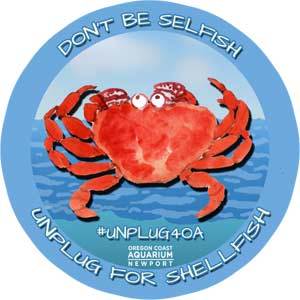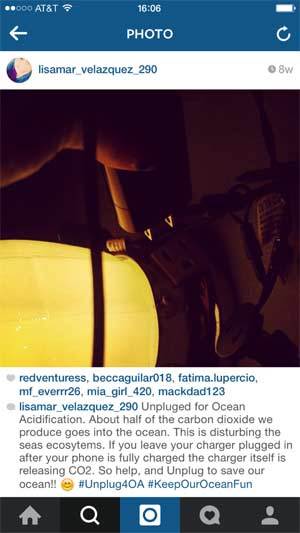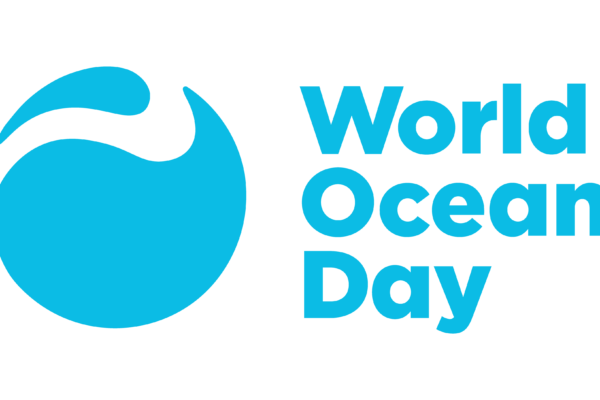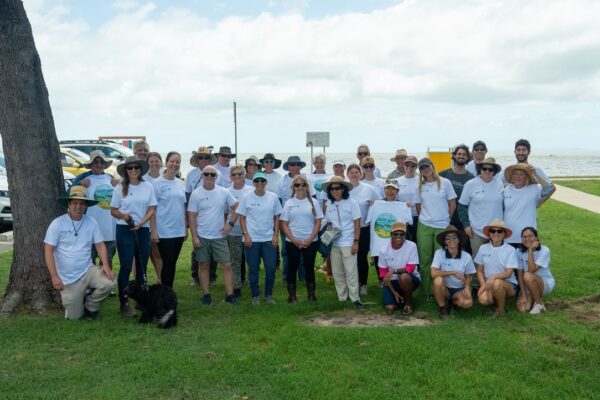This guest post by Teresa Mealy of Oregon Coast Aquarium is the final update on their Innovative Solutions Grants+ project, which put teens in the driver's seat of a peer-targeted conservation campaign! Thank you and congrats to Teresa, Kerry Carlin-Morgan, and everyone at the Aquarium for your great work.
Letting youth lead the way 
The Oregon Coast Aquarium, with generous support from The Ocean Project, endeavored to understand how to connect teens to ocean issues and then propel them to action. The Aquarium selected four highly motivated Youth Volunteers to spearhead the project and, ultimately, devise a social marketing campaign that would connect local teens with community action.
Throughout 2014 and into 2015, these youth, who called themselves the MOANA Group (Making Ocean Acidification Nationally Aware), researched, studied and shared the science of ocean acidification. They examined ocean acidification through the lens of community based social marketing, identified specific actions that local teens could do on their own to positively impact the marine ecosystem, and then looked to the opportunities available in classroom visits and social media.
Taking the lead, they created #Unplug4OA to see if the could engage and inspire their peers. Over 750 students have heard their call, and the movement is just getting started!
Advice for similar projects
Here are a few key takeaways for other aquariums and zoos that might be considering something similar:
Focus on action: A direct call to action proved very impactful when engaging a teen audience, especially when tied to a moderate introduction to the science. Too much science and issue information tended to be overwhelming, bogging down the presentation and taking the focus away from action.
Youth are awesome: Youth volunteers who were already invested in the Aquarium’s mission provided a great resource, as that allows you to jump ahead and focus on empowering them to create a campaign that will engage their peers. Moreover, their peers were impressed to find out that high school students who volunteer at the Aquarium are confident in leadership roles and empowered to teach about ocean issues.
Give youth a chance: Giving teens control of the design and implementation of a project can be risky (and intimidating) but is well worth it. Teens feel not only empowered, but take ownership of the project and are highly invested in its success.
Read on for more details on this innovative project:
Dreaming Big
Here at the Aquarium, we wanted our youth volunteers to feel empowered to communicate to their peers about ocean acidification. We wanted these teens to be agents of change, and teach local youth about ocean acidification (OA), their connection to OA and its impact on their communities. Most importantly with this project, we wanted to ensure that every teenager the campaign reached recognized in turn that their actions can make a difference to help address OA.
To empower these teens to act as confident advocates, we challenged them to spearhead the campaign’s research, creation and implementation. We gave them the freedom to direct the entire creative and design process of this social marketing project. Typically, a campaign like this - from the approach to the ask to the evaluation - would have been carefully crafted by staff for the teens just to implement, so turning control over to the teens from the start was exciting and innovative, yet also risky and somewhat daunting.
Turning It Over to the Teens
The MOANA Group already had the facts about OA, but we knew that it would take more than that for them to create a campaign, so we contracted with a social marketing consultant to teach them how to design a compelling, action-motivating campaign. Action Research’s President, Jennifer Tabinico, developed a course for the youth volunteers to learn about this specialized marketing process and coached the teens through the extensive process of developing their campaign.
The teens polled their peers to understand what actions are feasible for the typical teenager to take to minimize their impact on OA, and what are the barriers and benefits to implementation of each action. The training this grant funded taught the MOANA Group that a key to the community based social marketing framework is that the "asks" must be as directly related to the audience as possible. Their research led the teens to conclude that asking their peers to unplug cell phone chargers, game consuls and other electronics would be the most relatable solution with the greatest potential impact.
With a call to action identified, the MOANA Group started working through the creative process to identify engagement opportunities, and develop memorable slogans and reminder devices. They decided the best place to reach their target audience would be through outreach programs that would take them into middle and high school classrooms. The youth volunteers designed a flexible program that could adapt to discussion or presentation style formats, depending on each class’s needs.
The teens again took the lead when it came time to implement their ideas. They arranged presentation times and presented portions of, or the entire program, to their peers. To assess their audiences’ prior understanding, they asked them to jot down what they knew about ocean acidification, and what they could do about it. At the end of each program, MOANA Group introduced their "ask" - asking their peers to unplug cell phone chargers, game consuls and other electronics as a step that helps address the issue - and shared their experience developing the campaign. They also called on the audience to spread the campaign’s influence by posting on social media, using #Unplug4OA.
Following the program, the student audience was surveyed about what they could recall from the presentation and if they took action. Surveys were collected from the school either two weeks or two months after the presentation. Armed with these results, the MOANA Group was able to assess the impact their campaign made.
Changes, challenges and connections
The campaign’s target audience was high school students, but an early opportunity arose when a few teachers encouraged the group also to present to their middle school students. This provided an opportunity to broaden the audience, but it did require some changes to the dynamics of the presentation. Middle school students were more interested in participating in the presentation, and more inclined to ask questions than high school students. However when presenting to middle schools, we had to adapt our program to include some basic science concepts which high school students usually understand (E.g. what is pH, production of CO2, etc.). And when surveying students afterward, we found that the high school students were more likely to remember the targeted call to action, whereas the middle school students were more likely to remember general concepts from the presentation, but not the ask.
After the first classroom presentations, the MOANA Group also began to see some small changes they would need to make to their campaign's approach. One immediately apparent concern was accessibility to social media. Some schools had firewall systems that blocked students from accessing social media on their phones while on school grounds. They had also assumed most students were using social media, but when the opportunity arose to speak to middle school students, they found a measurable distinction between middle and high school students, with a higher proportion of the latter promoting #Unplug4OA. These challenges proved to be some of the more difficult to overcome in the campaign; but these efforts were worthwhile incorporating social media into the program helped the campaign reach teens who did not see the MOANA Group’s presentation.
When youth volunteers were not available to lead presentations, myself and other Aquarium staff filled their role. This provided us another variable to consider while assessing the impact of the campaign. We were a bit surprised that the adult led programs did seem to achieve the same response to calls to action and social media sharing. But we also couldn't help but notice that the youth volunteers engaged their peers in discussions about ocean acidification, their classmates appeared to connect more passionately with the issue. Both the adult and teen presenters proved impactful, but the messages and the ask seemed to resonate more strongly with middle and high school students when their peers presented the issue and campaign.
For Aquarium staff, we were very comfortable with the idea of a campaign that would involve our teen volunteers asking others to join in taking action on an issue like OA, as that we'd done before. But it was quite new to hand the reins to the youth volunteers, giving them the leadership over the campaign and have staff play the support role. It also was a switch for the youth volunteers to go from an adult led programs to one they would lead, but with the right tools and time to communicate, they took to the challenge and made us all proud. They exuded enthusiasm and motivation, passion and drive while working on the campaign, but, that said, we learned that we needed to allocate more time for the development and implementation process, which took longer than originally estimated, largely due to conflicting schedules with the youth volunteers’ school and extracurricular activities. Yet even with the constantly changing timeline, the youth volunteers remained positive and committed to the campaign, which was encouraging to all the adults working to support them.
These challenges provided lessons for the MOANA Group, and that, coupled with what they created, prepares them for the future.
The campaign’s impact: youth are awesome!
Despite the challenges and changes, the results gathered showed the campaign made an impact.
While we are still sifting though all of the data we collected, our preliminary results shows that the students in the audience have been able to recall many aspects of the presentation. Even weeks later, the majority recalled the topic or theme, citing the impact of ocean acidification on sea life or repeating one of the campaign catch phrases. More impressively:
- Approximately 50% of the students recalled unplugging electronics as an action they can take to reduce CO2 absorbed by the ocean (and about 35% say that it is an action they now do!).
- Even more impactful, approximately 40% of students also reported that they shared information they learned from the MOANA Group with their friends or family. And the students’ anecdotes supported their survey responses.
In keeping with the findings and recommendations from the public opinion research by The Ocean Project and others, the focus of the presentation was on the call to action, with just brief background on the science of OA, and this helped shape the results. Most of the survey responses included specific examples of behavior changes, like one student who said her mom unplugged her hair straightener after hearing about the MOANA Group presentation at dinner.
The youth volunteers also demonstrated a measurable increase in confidence when talking about ocean acidification with their peers, as well as when asking their peers to change their behavior. One MOANA Group member said, “I've seen the OA swag all over my school and many of my peers have been very willing to learn. Many have told me they have begun unplugging their appliances and chargers.” Another said he felt, “Empower(ed). I also feel special that I can confidently talk about the topic and I have the tools to show others how they can help as well.” Empowerment seemed to echo through their final evaluations, another youth volunteer said, “I feel empowered. I love educating my peers and if I can alter their habits I will do my best to do so. This program has helped me get out of my comfort zone, and I'm very thankful for that.”
So Bright, We Need to Wear Shades
The Oregon Coast Aquarium is thankful for the opportunity this grant gave the youth volunteers. Thanks to their new found empowerment we already are planning for more projects just around the bend. In addition to continuing the outreach program in the schools, we plan to share our community based social marketing and ocean acidification experiences with other local and regional teen groups, and also are sharing more of our experience with the team from the Woodland Park Zoo as they embark on their own Innovative Solutions+ Grant. We also hope to continue to expand our program to the Hispanic community, another key audience identified in the public opinion research and a demographic which makes up 30% of students in our local high school. With so many future goals, the close of this project feels like we are just wrapping up stage one, and launching into for a bright future.






